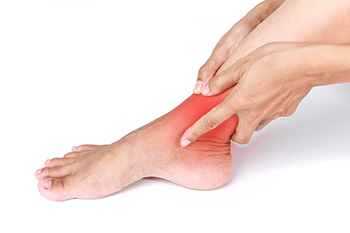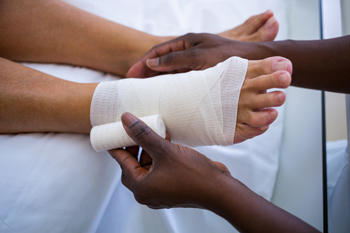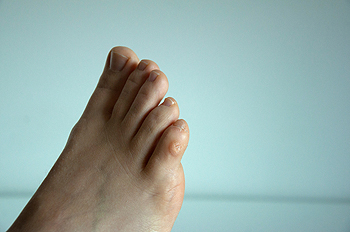Items filtered by date: January 2023
Medical Conditions Can Cause Tarsal Tunnel Syndrome

The tibial nerve is located in the tarsal tunnel in back of the ankle. This is a narrow tunnel, and this nerve can become compressed from a sprained ankle or a bone spur. Additionally, other conditions may lead to developing tarsal tunnel syndrome, including diabetes, flat feet, or a thyroid disorder. Some of the symptoms that are associated with this ailment can include toe pain and foot muscles that have become weakened. There may also be a burning sensation or tingling feeling in the feet, and can radiate to the toes. There may be an inability to curl the toes or twist the ankle, and this may be indicative of tarsal tunnel syndrome. Orthotics may be prescribed if flat feet are a reason for this condition to develop, and it may be beneficial to perform specific stretches to strengthen the ankle. If you have pain in your ankle, please confer with a podiatrist who can accurately diagnose tarsal tunnel syndrome, and guide you toward the correct treatment.
Tarsal tunnel syndrome can be very uncomfortable to live with. If you are experiencing tarsal tunnel syndrome, contact Shaun J. Limon, DPM and Lisa Griffith-Limon, DPM of Limons Foot & Ankle Care. Our doctors can provide the care you need to keep you pain-free and on your feet.
Tarsal Tunnel Syndrome
Tarsal tunnel syndrome, which can also be called tibial nerve dysfunction, is an uncommon condition of misfiring peripheral nerves in the foot. The tibial nerve is the peripheral nerve in the leg responsible for sensation and movement of the foot and calf muscles. In tarsal tunnel syndrome, the tibial nerve is damaged, causing problems with movement and feeling in the foot of the affected leg.
Common Cause of Tarsal Tunnel Syndrome
- Involves pressure or an injury, direct pressure on the tibial nerve for an extended period of time, sometimes caused by other body structures close by or near the knee.
- Diseases that damage nerves, including diabetes, may cause tarsal tunnel syndrome.
- At times, tarsal tunnel syndrome can appear without an obvious cause in some cases.
The Effects of Tarsal Tunnel Syndrome
- Different sensations, an afflicted person may experience pain, tingling, burning or other unusual sensations in the foot of the affected leg.
- The foot muscles, toes and ankle become weaker, and curling your toes or flexing your foot can become difficult.
- If condition worsens, infections and ulcers may develop on the foot that is experiencing the syndrome.
A physical exam of the leg can help identify the presence of tarsal tunnel syndrome. Medical tests, such as a nerve biopsy, are also used to diagnose the condition. Patients may receive physical therapy and prescriptive medication. In extreme cases, some may require surgery.
If you have any questions please feel free to contact our offices located in Bradenton and Lakewood Ranch, FL . We offer the newest diagnostic and treatment technologies for all your foot and ankle needs.
Effective Tips on How to Care For Your Feet

The average person takes hundreds of steps every day, which adds up to thousands per week. This can be one reason why people have achy feet at the end of the day, and practicing everyday foot care techniques may help to alleviate the discomfort. This can begin by washing and drying the feet thoroughly, followed by applying a good moisturizer on them. Many people like to sprinkle powder on their feet, which can help to keep the feet fresh by absorbing excess moisture. It is important to keep the toenails trimmed, and this is properly done by cutting them straight across instead of in a curved fashion. This is an effective way of preventing ingrown toenails from developing. Wearing shoes that fit correctly is another way of taking care of our feet. It is beneficial to choose shoes that have adequate room for the toes to move freely in, which may be helpful in preventing hammertoe and bunions from forming. If you would like additional information and tips on daily foot care habits, please confer with a podiatrist.
Everyday foot care is very important to prevent infection and other foot ailments. If you need your feet checked, contact Shaun J. Limon, DPM and Lisa Griffith-Limon, DPM from Limons Foot & Ankle Care. Our doctors can provide the care you need to keep you pain-free and on your feet.
Everyday Foot Care
Often, people take care of their bodies, face and hair more so than they do for their feet. But the feet are a very important aspect of our bodies, and one that we should pay more attention to. Without our feet, we would not be able to perform most daily tasks.
It is best to check your feet regularly to make sure there are no new bruises or cuts that you may not have noticed before. For dry feet, moisturizer can easily be a remedy and can be applied as often as necessary to the affected areas. Wearing shoes that fit well can also help you maintain good foot health, as well as making it easier to walk and do daily activities without the stress or pain of ill-fitting shoes, high heels, or even flip flops. Wearing clean socks with closed shoes is important to ensure that sweat and bacteria do not accumulate within the shoe. Clean socks help to prevent Athlete’s foot, fungi problems, bad odors, and can absorb sweat.
If you have any questions please feel free to contact our offices located in Bradenton and Lakewood Ranch, FL . We offer the newest diagnostic and treatment technologies for all your foot and ankle needs.
Elastic Bandages and the Feet

Sometimes when we develop a cut or wound on the human body, it can be beneficial to cover up the wound with a bandage to protect the skin and help it heal. The feet are no different, and sometimes they might benefit from the use of a bandage when wounds develop. To help keep bandages held in the proper place, the use of an elastic bandage on top may be useful. These bandages give extra support to an area of the foot that is injured. Elastic bandages are usually applied to the feet by wrapping or crossing the bandage across the foot, leaving the heel exposed. It can be helpful to refrain from wrapping the elastic bandage too tightly around the foot which may help to prevent cutting off blood circulation to the feet. Elastic bandages are not for everyone. However, if you are interested in elastic bandages and believe they may help you keep your bandages in place, please contact a podiatrist for guidance today.
Wound care is an important part in dealing with diabetes. If you have diabetes and a foot wound or would like more information about wound care for diabetics, consult with Shaun J. Limon, DPM and Lisa Griffith-Limon, DPM from Limons Foot & Ankle Care. Our doctors will assess your condition and provide you with quality foot and ankle treatment.
What Is Wound Care?
Wound care is the practice of taking proper care of a wound. This can range from the smallest to the largest of wounds. While everyone can benefit from proper wound care, it is much more important for diabetics. Diabetics often suffer from poor blood circulation which causes wounds to heal much slower than they would in a non-diabetic.
What Is the Importance of Wound Care?
While it may not seem apparent with small ulcers on the foot, for diabetics, any size ulcer can become infected. Diabetics often also suffer from neuropathy, or nerve loss. This means they might not even feel when they have an ulcer on their foot. If the wound becomes severely infected, amputation may be necessary. Therefore, it is of the upmost importance to properly care for any and all foot wounds.
How to Care for Wounds
The best way to care for foot wounds is to prevent them. For diabetics, this means daily inspections of the feet for any signs of abnormalities or ulcers. It is also recommended to see a podiatrist several times a year for a foot inspection. If you do have an ulcer, run the wound under water to clear dirt from the wound; then apply antibiotic ointment to the wound and cover with a bandage. Bandages should be changed daily and keeping pressure off the wound is smart. It is advised to see a podiatrist, who can keep an eye on it.
If you have any questions, please feel free to contact our offices located in Bradenton and Lakewood Ranch, FL . We offer the newest diagnostic and treatment technologies for all your foot care needs.
Ankle Sprains and Jumping Rope

Jumping rope is one of the most common and popular forms of exercise among young children. Many adults also partake in jumping rope as an easy way to burn calories. However, sometimes engaging in this activity can put someone at an increased risk of developing certain foot injuries. For example, jumping rope without proper form can increase one’s risk of developing an ankle sprain. Commonly, even the most experienced rope jumpers will land awkwardly or dangerously while jumping rope. Sometimes when an individual lands incorrectly, the ankle ligaments can become stressed or even torn. This is what can ultimately contribute to ankle injuries such as ankle sprains. As a result, the ankle may even demonstrate some swelling or cause the person pain. Whenever you think that you might have sprained your ankle, it is always best to err on the side of caution and schedule an appointment with a podiatrist who can assist you.
Ankle sprains are common but need immediate attention. If you need your feet checked, contact Shaun J. Limon, DPM and Lisa Griffith-Limon, DPM from Limons Foot & Ankle Care. Our doctors can provide the care you need to keep you pain-free and on your feet.
How Does an Ankle Sprain Occur?
Ankle sprains take place when the ligaments in your ankle are torn or stretched beyond their limits. There are multiple ways that the ankle can become injured, including twisting or rolling over onto your ankle, putting undue stress on it, or causing trauma to the ankle itself.
What Are the Symptoms?
- Mild to moderate bruising
- Limited mobility
- Swelling
- Discoloration of the skin (depending on severity)
Preventing a Sprain
- Wearing appropriate shoes for the occasion
- Stretching before exercises and sports
- Knowing your limits
Treatment of a Sprain
Treatment of a sprain depends on the severity. Many times, people are told to rest and remain off their feet completely, while others are given an air cast. If the sprain is very severe, surgery may be required.
If you have suffered an ankle sprain previously, you may want to consider additional support such as a brace and regular exercises to strengthen the ankle.
If you have any questions please feel free to contact our offices located in Bradenton and Lakewood Ranch, FL . We offer the newest diagnostic and treatment technologies for all your foot and ankle needs.
Three Types of Corns

A small, hardened area of skin that has formed on the foot may indicate a corn has developed. They generally develop on the outside of the pinky toe, or on the bottom of the foot, as a result of excessive friction. This can happen from wearing shoes and socks that are too tight, and temporary relief may come from choosing to wear shoes that fit correctly. A corn on the foot can cause severe pain and discomfort, despite their small size. There are three types of corns that can develop, consisting of hard, soft, and seed corns. The former is considered to be the most common type of corn, and can develop on top or on the side of the toes. Soft corns generally develop between the toes, as a result of excess moisture that can accumulate there. The latter forms on the soles of the feet, and are generally small in size. Research has shown the best method to prevent a corn from developing is by wearing shoes that are comfortable. This is generally successful in alleviating pressure against the toes. Many people who have developed corns seek the advice of a podiatrist who can effectively remove them, and offer additional prevention techniques.
If you have any concerns regarding your feet and ankles, contact Shaun J. Limon, DPM and Lisa Griffith-Limon, DPM of Limons Foot & Ankle Care. Our doctors will treat your foot and ankle needs.
Corns: What Are They? and How Do You Get Rid of Them?
Corns can be described as areas of the skin that have thickened to the point of becoming painful or irritating. They are often layers and layers of the skin that have become dry and rough, and are normally smaller than calluses.
Ways to Prevent Corns
There are many ways to get rid of painful corns such as wearing:
- Well-fitting socks
- Comfortable shoes that are not tight around your foot
- Shoes that offer support
Treating Corns
Treatment of corns involves removing the dead skin that has built up in the specific area of the foot. Consult with Our doctors to determine the best treatment option for your case of corns.
If you have any questions please feel free to contact our offices located in Bradenton and Lakewood Ranch, FL . We offer the newest diagnostic and treatment technologies for all your foot and ankle needs.


